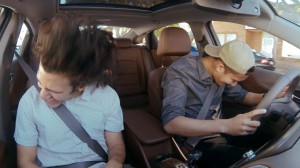Parents of teen drivers can do one simple thing to make their progeny better behind the wheel: drive better themselves.
According to a new survey conducted earlier this month among 1,000 U.S. teen drivers, 79% of them said they rely on their parents or guardians more than anyone else to serve as a role model for their driving.
As vehicle crashes are the leading cause of death for teenagers, says the National Safety Council, and talking with young drivers about appropriate behavior when driving, and then modeling it is the surest way to produce a smarter, better teenaged driver.
Parents sometimes exhibit behaviors that are less than stellar, according to Wakefield Research and Hum Verizon, which conducted the study for National Teen Driver Safety Week, Oct. 21–28.
(Traffic fatalities fall in 2017, stemming two-year rise. Click Here for the story.)

Teen drivers are still texting and driving at alarming rates, but those rates are coming down slightly.
The survey revealed that teens often take note of wrong or inappropriate behavior by their parents while driving, including:
- 80% of teen drivers have witnessed their parent or guardian drive unsafely in the past year
- 57% of teen drivers have witnessed their parents drive over the speed limit
- 46% of teen drivers have witnessed their parents slam on their brakes
- 25% of teen drivers have witnessed their parents drive without a seat belt on and make illegal maneuvers
(Better headlights could save pedestrians’ lives. Click Here for the story.)
Since many teen drivers may not be learning the necessary safety skills from their parents, they are not always equipped to address or fix a safety issue when they’re alone on the road. The study noted that:
- Only half of teen drivers would know what to do if they get a flat tire (51%) or get into an accident (49%)
- Only 41% would know what do if an emergency alert goes off in their car
Some parents may be doing a better job than expected as overall, traffic fatalities are on decline after a two-year rise. In 2017, deaths dropped 1.8% despite the fact that Americans drove more than ever.
(To see why advanced driver assistance systems could raise, not cut insurance costs, Click Here.)
In 2017, deaths related to pedestrians, drunk driving, speeding, bicyclists and motorcyclists all fell. The overall rate of fatalities fell to 1.16 deaths per 100 million miles traveled. This happened ever as Americans set another record for miles traveled behind the wheel, jumping 1.2% last year.


